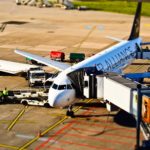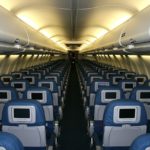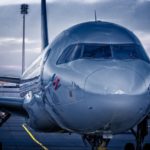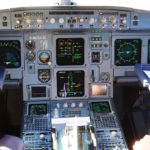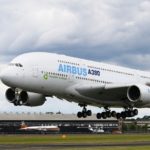Aircraft Disinfection refers to specific service and measures taken to control, deactivate or kill infectious agents, such as disinfectant of viruses (coronavirus disinfect etc.) and bacteria. Aircraft Disinfection is normally undertaken when there is a special requirement of the disinfectant service, during periodic maintenance checks or after a public health event, such as the suspected carriage of an infectious passenger.
Difference Between Aircraft Disinfection and Aircraft Cleaning
Aircraft Cleaning refers to the removal of germs, dirt, and impurities from surfaces. It does not kill germs, but by removing them, it lowers their numbers and the risk of spreading infection.
Aircraft Disinfection refers to using chemicals, for example, EPA-registered disinfectants, to kill germs on surfaces. This process does not necessarily clean dirty surfaces or remove germs, but by killing germs on a surface after cleaning, it can further lower the risk of spreading infection.
Summary of Aircraft Disinfection Requirments
1. Requirements for Aircraft Disinfection Contract Company
A company hired to complete a needed task of aircraft disinfection service. In regards to cleaning and disinfecting aircraft of Coronavirus, Ebola virus, etc. the contract company will be specialized in disinfecting, handling, and discarding of toxic chemicals, infectious agents, and other hazardous materials with experience in cleaning biohazard and aircraft interiors.
2. Requirements for Aircraft Disinfection Disinfection Product
A product that is used for aircraft disinfection service that makes certain biological agents inactive. Specific to Coronavirus, Ebola, etc. use an EPA-registered disinfectant according to the manufacturer’s instruction with a libel claim against a non-enveloped virus, such as norovirus, rotavirus, adenovirus, or poliovirus.
3. Requirements for Personal protective equipment (PPE)
Equipment is worn during the aircraft disinfection activities to prevent exposure to hazardous substances (e.g., chemicals, infectious agents, particles). For in-flight Ebola infection control on commercial passenger aircraft, available PPE may be limited to the equipment in the Universal Precautions or Medical Kits (e.g., gloves, eye protection and/ or facemask). For Ebola environmental cleaning and disinfection by the contract company, the level of PPE will vary due to the contamination level and chemicals used for cleaning and disinfecting. For coronavirus disinfection, adhere to the most updated recommendations.
Risk Factors
The main source of infection for other travellers is from an infected person, and proximity to an infected person is an important risk factor for airborne infection. Once an infected person has left the scene, most of the risk from droplet exposure will have been removed. The residence time of suspended airborne particles may be longer and will depend on the particles’ mass and on the ventilation rate/air circulation patterns in the cabin (ANSI/ASHRAE, 2008).
Airborne exposure aside, there is a concern that the agent of disease (pathogen) can remain in the airport or aircraft environment by contaminating common surfaces (e.g. fomites) after the infected traveller has departed. However, the guidance in this chapter is directed primarily at the second and third possible routes of transmission. The cause of illness for an individual traveller may not be known immediately and possibly not for some time afterwards; in many cases, the diagnosis may never be known. This guidance, therefore, adopts a “universal precaution” approach that treats all respiratory secretions, faeces, blood and other body fluids as potentially infectious.
Sometimes, a case of communicable disease is known only several days (or longer) after the infected person has travelled and may have deposited pathogens on surfaces in the airport or on the aircraft. The risk of infection upon contact with such contaminated surfaces will depend on the viability of the organism, the number of organisms, whether the surface has been properly cleaned and/or disinfected, whether the pathogen is touched and transferred and also the susceptibility of the traveller. Frequent hand washing reduces the risk. As time passes and as a result of routine cleaning activities, the risk that any transmissible pathogens remain in place reduces, even without specific disinfection procedures.
There may be epidemiological information available to guide the public health response, such as an outbreak occurring at the origin of the flight (e.g. the 2003 episode of SARS). In such instances, public health experts recommend specific measures targeted at a particular pathogen.
How the Risk Can be Reduced
To reduce the risk of transfer of pathogens from an infected person to others via surfaces or inanimate objects on the aircraft or in the airport, it is necessary for aircraft and airport operators and ground handling agents to have a coordinated plan in place to deal with the arrival of an affected1 aircraft having carried such a traveller or the presence of a person with a communicable disease in the airport.
For aircraft, the plan needs to take into account the unusual features of the aircraft cabin in comparison with a ground-based facility. For airports, the plan should address the challenge of managing potential contamination in a large public space, such as the terminal building. Such plans should also address potential contamination of an aircraft or airport with an infectious agent that is not transmitted person to person. Considering that it may be difficult to identify an aircraft carrying an infected person, the focus should be on
(a) the assumption that all aircraft are periodically occupied by infected travellers and therefore require routine and frequent cleaning and disinfection and
(b) the fact that certain events (e.g. persistent coughing on board) may increase the risk of disease transmission and that such incidents should be investigated so that, if a case of communicable disease is suspected, it leads to specific disinfection measures.
Risk of Disinfectants
Disinfectants tend to be oxidizers, and the interior of an aircraft contains many materials susceptible to damage from cleaning products and disinfectants. Metals used in the construction of the aircraft may corrode upon exposure to such products, safety-critical cables and wires may deteriorate on exposure and aircraft furnishings may have their fire resistance properties reduced. It is, therefore, necessary to exercise caution in selecting suitable products and before applying these products in aircraft. It is important to protect the health of the cleaning personnel and to ensure effective action; therefore, the manufacturer’s instructions must be followed carefully.
Recommendations
It is essential to provide a hygienic environment for travellers. Areas where food is prepared, stored and served, any surfaces commonly touched by people and washroom facilities, among others, should be kept free from contaminants that might compromise human health, even when there is no identified outbreak of disease. Prevention or mitigation of disease transmission is the goal. Hygienic conditions also minimize the likelihood of infestation by rodents, as vectors of disease.

